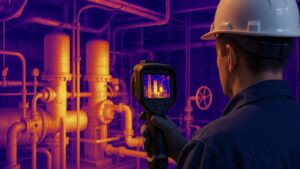The marine sector is making great efforts to reduce carbon emissions from port and shipping activities. Two methods that ports are using to cut emissions are electrification and shore power. However, there are issues with uptime and dependability when charging infrastructure is scaled up. These can disrupt port operations. Furthermore, damaged or faulty charging stations impact individual ships. It also creates broader bottlenecks that ripple across the port environment.
Self-healing technologies offer a potential way for ports. It maximizes charging availability and minimizes disruptive downtimes. These innovative systems have built-in redundancy and reconfiguration capabilities. So, it detects faults and recovers functionality automatically. Let us dive into self healing charging stations and learn about their benefits, challenges, and more.
Self-Healing Charging Stations: How Do They Work?
Self-healing charging stations are electric vehicle charging stations that detect and automatically fix small problems or issues. They use a variety of technologies and design principles. It helps them to achieve automated fault detection, isolation, and recovery. When anomalies occur, the charging station can sense the problem. Furthermore, it then reroutes power flows by activating redundant backup components.
Several key capabilities enable the self-healing functionality:
- Embedded sensors monitor a range of parameters. It includes power flow, temperatures, vibration, and other metrics. It helps to identify potential faults or abnormal operating conditions quickly. Moreover, the sensors provide constant health monitoring of components across the charging system.
- AI and analytics use advanced pattern recognition algorithms, ML models, and more. It analyzes real-time data from sensors. Additionally, the AI reads problems and predicts failures. This is by detecting any deviations from usual behavior.
- Reconfiguration occurs through automated switching capabilities. They allow the charging station to dynamically re-route power delivery. This is around any failed or overloaded components. So, this maintains the continuity of charging service to the ship. It also removes port downtime.
- Islanding enables the isolation of a fault in a small section of the system. It also smoothly keeps the power flowing to the rest of the components. As a result, this prevents cascading failures from propagating.
- The segmented design utilizes separate segments or zones. These allow the isolation of faults while the rest of the charging infrastructure remains operational.
- Rapid controls use high-speed semiconductors like thyristors and IGBTs. It facilitates reconfiguration and isolation of faults. This is within milliseconds before major disruptions occur.
The sophistication of self-healing capabilities varies. Some systems simply have redundant components that provide basic backup. Moreover, more advanced designs have active control systems running AI and advanced algorithms.
Let us look at the benefits that self healing charging stations provide.
Self-Healing Charging Stations: Key Benefits for Ports
For ports pursuing shore power strategies, self-healing charging stations offer clear advantages over conventional passive charging systems. By minimizing disturbances and downtime, self-healing chargers can enhance the feasibility and scalability of port electrification. Let us look at the benefits of self healing charging stations in depth:
Maximized Uptime and Availability
With self-healing redundancy, a single faulty converter or distribution panel won’t force a ship to run dirty auxiliary engines instead of clean shore power. The charging system maintains continuity to the vessel. This is through automated reconfiguration around damaged components. As a result, this maximizes clean power usage. It also prevents disruptive downtime while a technician is dispatched for repairs.
Reduced Bottlenecks and Disruption
Charging disturbances don’t just impact an individual ship. They can propagate delays and congestion across the port. So, by keeping overall charging operational even with damaged chargers, self-healing charging stations avoid such bottlenecks. Moreover, smooth traffic flow is maintained without backups or scheduling headaches from charging disruptions.
Lower Maintenance Overheads
Thanks to redundancy and graceful degradation, damaged charger components no longer require urgent replacement. So, this allows maintenance to be scheduled during convenient windows. This is so technicians aren’t running around the port reacting to emergency repairs at all hours. Additionally, more efficient maintenance planning also reduces costs associated. This is with labor, repair parts inventory, and equipment downtime. It also reduces port downtime
Enhanced Resilience and Reliability
Ports are challenging environments with weather, corrosion, vibrations, and other hazards. Self-healing chargers offer enhanced robustness and reliability. This is compared to failure-prone passive systems prone to go offline from a single fault. Furthermore, automated reconfiguration provides continuous operation through most damage scenarios cutting port downtime.
Simplified System Scalability
Expanding charging capacity normally decreases overall reliability as complexity grows. However, self-healing charging stations’s redundancy makes scaling up shore power seamless. This is without downtime or reliability trade-offs. So, ports can easily expand charging capacity to meet growing electrification needs.
Future-Proofed Infrastructure
Self-healing charging stations provide charging infrastructure designed for the larger power flows and electrical complexity arising from expanded electrification. Moreover, the automated redundancy foundations enable cost-effective expansion to meet future demands.
Now that we have looked at the benefits, are there any challenges to it? Let’s find out.
Self-Healing Charging Stations: Challenges and Limitations to Overcome
While promising, self-healing technology has limitations and challenges to address. It is only then that widespread port adoption is feasible. So, let us look at them ahead:
Higher Upfront Costs
The redundancy and advanced components increase upfront costs over standard passive chargers. Moreover, modular and reconfigurable designs using mass-produced components can enhance economies of scale and bring down costs.
Complexity and New Maintenance Needs
Although reducing some maintenance, self-healing systems have their complexity. It requires personnel training on the redundancy and logic systems. However, integrators can simplify internal designs while ports develop training programs. It builds the required workforce skills.
Safety Considerations
Reconfiguring high voltage shore power grids raises arc flash and other safety risks requiring strong safeguards. So, safety can be enhanced through multiple levels of protective relaying. It can also enhance with automated ground fault interruption, and advanced switchgear-like solid-state breakers.
Difficulty Retrofitting Legacy Infrastructure
It’s much easier to implement self-healing capabilities in new charging stations rather than retrofitting existing infrastructure. However, a modular approach can help overcome this. This is by allowing self-healing “modules” to be added to legacy systems.
Cybersecurity Vulnerabilities
Actively controlled, software-driven chargers increase potential cyber risks. However, cybersecure hardware/software designs and best practice network security policies can mitigate these risks.
Immature Industry Standards
Lack of standards may hamper interoperability between different manufacturers’ systems. So, proactive standards development collaboration between ports and vendors can help accelerate agreement on common self-healing functionality.
Insufficient In-Field Experience
More real-world data is needed on self-healing performance. However, this can be obtained through deliberate piloting. Moreover, close monitoring and data sharing among early adopters will build the experience base.
Let us move ahead and look at the regulations necessary for self healing charging stations.
Self-Healing Charging Stations: The Evolution of Standards and Regulations
For self-healing shore power to become mainstream, standards, and regulations will need to advance. It will provide a proper framework. Furthermore, groups like the IEC, IEEE, ISO, and IMO have important roles to play.
Some of the key areas that standards bodies will need to address include:
- Safety and reliability certification protocols specific to self-healing capabilities
- Testing methodology to independently validate claims of availability, redundancy, and fault response
- Interoperability, compatibility, and performance requirements
- Communication protocols for equipment health monitoring and diagnostics
- Functional specifications for different use cases like ship charging
- Cybersecurity of actively controlled charging infrastructure
- Skill and training standards for maintenance of self-healing systems
In addition, regulators and class organizations like DNV and RINA must work closely with ports and technology vendors. This is to establish appropriate rules and guidelines around safety, risk management, and reliability.
However, it will be critical for regulations to take a collaborative approach. It should enhance rather than impede the adoption of self-healing technology given its benefits. Moreover, ports and policymakers will need to spearhead frameworks that balance innovation, safety, and emission goals.
With supportive policies and standards in place, the stage is set for accelerated adoption of self-healing technology by ports. So what might the road ahead look like?
The Road Ahead for Self-Healing Shore Power
Self-healing charging stations are poised to have an important impact as ports globally scale up electrification initiatives. Wider adoption over the next decade seems inevitable. This is given the clear advantages of boosting uptime, resilience, and scalability. However, work remains to bring down costs, refine systems, and build supportive standards and regulations.
More pilot deployments at pioneering ports will generate crucial data on real-world performance to validate claims. Furthermore, partnerships between ports and technology firms will facilitate knowledge sharing and refinement. Moreover, industry associations have an important role to play in convening discussions to build consensus.
Tighter integration of self-healing chargers with port energy management and optimization systems will further maximize uptime and efficiency benefits. As a whole, increased digitization and automation will amplify the advantages of self-healing technology.
A collaborative policy environment that sees self-healing systems not as a risk to be regulated but as an enabler of emission goals will be constructive. So, with the right partnerships and smart policies, ports could reap substantial benefits. This is from self-healing technologies as a tool for cost-effective shore power expansion.
To Sum Up
The global shift towards port electrification is encountering growing pains as shore power infrastructure scales up. Self-healing charging stations offer a promising way to smooth the transition, This is by boosting uptime, resilience, and scalability. Moreover, early adopters are already proving the concept and experiencing the benefits firsthand. For shore power to reach its full potential in reducing port emissions/ port downtime, self-healing capabilities may become an essential enabling ingredient. Wider adoption seems imminent as costs improve and ports recognize the advantages of their operations. Looking ahead, Future Bridge’s upcoming Net Zero Ports & Harbours summit in Barcelona, Spain on March 14-15, 2024 will dive deep into electrification, charging infrastructure, and other facets of the maritime energy transition.
The event brings together ports, vessel operators, charging companies, and other stakeholders to discuss challenges and solutions like self-healing technology. Attendees will gain insights into best practices from global ports as well as connect with technology partners and vendors. The summit provides an unparalleled opportunity to learn about and influence the next wave of innovations that will shape sustainable port operations. Port authorities and operators looking to smooth their transition to shore power would derive tremendous value from participating. Register today!





